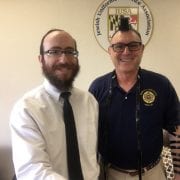The Rabbi and the Jewish War Veteran (JWV) Maryland Post 167 Chaplain Andrew Wolkstein
While attending the Maryland JWV District meeting in June 2017, COL Erwin Burtnick, USA (retired) District Commander, introduced me to Rabbi Chesky Tenenbaum. As the newly appointed Chaplain of the JWV Post 167 in Owings Mills, Maryland, I was interested in any advice I could receive from the Rabbi. It turned out that the Rabbi was thinking of joining the National Guard and a meeting was set up to meet later in the month.
During my follow-up meeting with Rabbi Tenenbaum, we discussed the Air and Army National Guard Chaplaincy program. Prior to our meeting I contacted Chaplain (COL) Wm Sean Lee, Joint Force Headquarters, Maryland National Guard, Chaplain to ask if Chaplain Lee know of any openings in the Chaplain Corps and he confirmed yes. As a retired 167th Aeromedical Evacuation Squadron (AES) Commander, West Virginia Air National Guard (ANG) and a Flight Nurse, I discussed how important the Chaplains are for the deployed as well as wounded Service Members. My experience in Bosnia (Tazar, Hungary) and Iraq (Baghdad) the Chaplains worked synergistically with the Mobile Aeromedical Staging Facility (MASF) personnel in treating the wounded, mentally, physically, and spiritually. A MASF is a passenger terminal for the wounded and ill Service Members, foreigners, and civilians awaiting transportation to tertiary care (from the battlefield to Kuwait, Germany, or directly to the United States). I will save that story for another time.…
I found out that Rabbi Tenenbaum is a Volunteer Chaplain (Major) in the Maryland Defense Force (MDDF). The MDDF is a volunteer military organization parallel to the Maryland National Guard and is designed to augment the National Guard during stateside emergencies.
I also found out that Rabbi Tenenbaum is the founder and Director of the Jewish Uniformed Service Association of Maryland (JUSA). JUSA provides current and retired Jewish Military, Police, Fire and Public Safety Members of the state of Maryland with religious educational and social support and activities, in connection with the observance of Jewish tradition. To find out more information, contact www.JewishUSAMD.org.
…and that leads to the attached picture, Rabbi Tenenbaum asked if I ever wore Tefillin, and as a Reform Jew growing up in New Jersey I had not. He invited me to wear Tefillin and pray together. I could not pass up this new experience.
This was my second Bar Mitzvah, the wearing of Tefillin. Tefillin is a Mitzvot (precept) of the Torah. “It is mentioned in Deuteronomy 6:8 ‘And you shall bind them for a sign upon your hand, and they shall be for ornaments between your eyes.’ Tefillin consists of two small leather boxes attached to leather straps. The two boxes each contain four sections of the Torah inscribed on parchment. These passages cite:
- The Shema (Deut. 6:4-9) – pronouncing the Unity of The One G-d.
- Vehaya (Deut. 11:13-21) – expressing G-d’s assurance to us of reward that will follow our observance of the Torah’s precepts, and warning of retribution for disobedience to them.
- Kadesh (Exodus 13:1-10) – the duty of the Jewish people to always remember the redemption from Egyptian bondage.
- Vehayah (Exodus13:11-16) – the obligation of every Jew to inform his children on these matters.
One of the boxes (the ‘hand Tefillin’) is placed upon the left arm so as to rest against the heart – the seat of the emotions, and the suspended leather strap is wound around the left arm, and around the middle finger of that hand. The other box (the ‘Head Tefillin’) is placed upon the head, above the forehead, so as to rest upon the cerebrum. In this manner our attention is directed to the head, heart and hand. It teaches us to dedicate ourselves to the service of G-d in all that we think, feel and do. It is also to teach us not to be governed solely by the impulse of the heart, lest that lead us into error and transgression. Nor are we to be governed by reason alone, for that may lead to harsh materialism.
You are never to old to learn new things.
Volume 71. Number 3. Fall 2017





Leave a Reply
Want to join the discussion?Feel free to contribute!